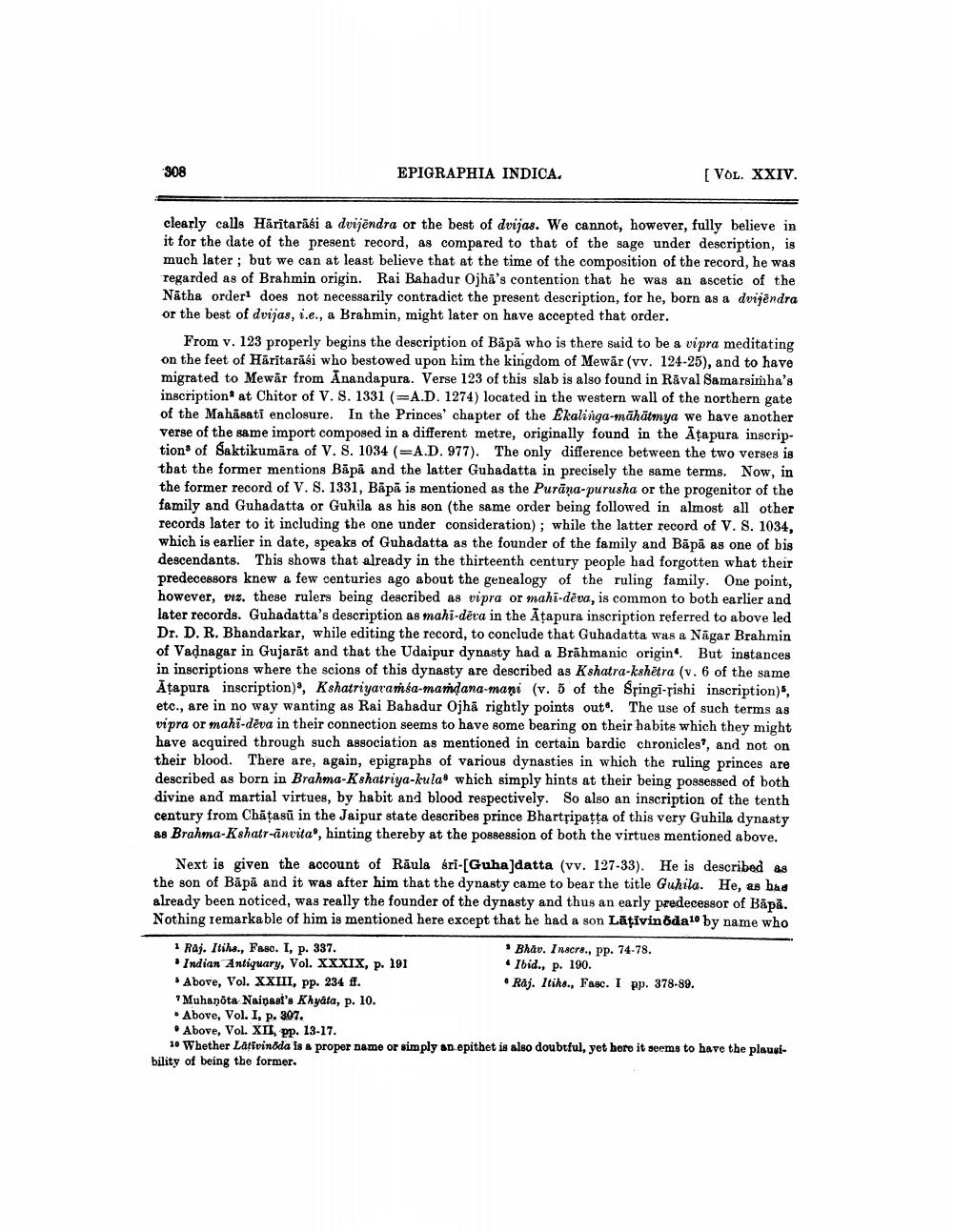________________
308
EPIGRAPHIA INDICA.
[VOL. XXIV.
clearly calls Haritaräsi a dvijendra or the best of dvijas. We cannot, however, fully believe in it for the date of the present record, as compared to that of the sage under description, is much later; but we can at least believe that at the time of the composition of the record, he was regarded as of Brahmin origin. Rai Bahadur Ojha's contention that he was an ascetic of the Nätha order does not necessarily contradict the present description, for he, born as a dvijëndra or the best of dvijas, i.e., a Brahmin, might later on have accepted that order.
From v. 123 properly begins the description of Bapa who is there said to be a vipra meditating on the feet of Häritarasi who bestowed upon him the kingdom of Mewar (vv. 124-25), and to have migrated to Mewar from Anandapura. Verse 123 of this slab is also found in Raval Samarsimha's inscription at Chitor of V. S. 1331 (=A.D. 1274) located in the western wall of the northern gate of the Mahasati enclosure. In the Princes' chapter of the Ekalinga-mahatmya we have another verse of the same import composed in a different metre, originally found in the Aṭapura inscriptions of Saktikumāra of V. S. 1034 (=A.D. 977). The only difference between the two verses is that the former mentions Bapa and the latter Guhadatta in precisely the same terms. Now, in the former record of V. S. 1331, Bäpä is mentioned as the Purana-purusha or the progenitor of the family and Guhadatta or Guhila as his son (the same order being followed in almost all other records later to it including the one under consideration); while the latter record of V. S. 1034, which is earlier in date, speaks of Guhadatta as the founder of the family and Bapa as one of bis descendants. This shows that already in the thirteenth century people had forgotten what their predecessors knew a few centuries ago about the genealogy of the ruling family. One point, however, viz. these rulers being described as vipra or mahi-deva, is common to both earlier and later records. Guhadatta's description as mahi-deva in the Aṭapura inscription referred to above led Dr. D. R. Bhandarkar, while editing the record, to conclude that Guhadatta was a Nagar Brahmin of Vadnagar in Gujarat and that the Udaipur dynasty had a Brahmanic origin. But instances in inscriptions where the scions of this dynasty are described as Kshatra-kshetra (v. 6 of the same Aṭapura inscription), Kshatriyavamsa-mamdana-mani (v. 5 of the Sringi-rishi inscription), etc., are in no way wanting as Rai Bahadur Ojha rightly points out. The use of such terms as vipra or mahi-deva in their connection seems to have some bearing on their habits which they might have acquired through such association as mentioned in certain bardic chronicles", and not on their blood. There are, again, epigraphs of various dynasties in which the ruling princes are described as born in Brahma-Kshatriya-kula which simply hints at their being possessed of both divine and martial virtues, by habit and blood respectively. So also an inscription of the tenth century from Chaṭasu in the Jaipur state describes prince Bhartripaṭṭa of this very Guhila dynasty as Brahma-Kshatr-ānvita', hinting thereby at the possession of both the virtues mentioned above.
Next is given the account of Raula śri-[Guha]datta (vv. 127-33). He is described as the son of Bäpä and it was after him that the dynasty came to bear the title Guhila. He, as has already been noticed, was really the founder of the dynasty and thus an early predecessor of Bapa. Nothing remarkable of him is mentioned here except that he had a son Lätivinöda10 by name who
1 Raj. Itihs., Fasc. I, p. 337. Indian Antiquary, Vol. XXXIX, p. 191
Above, Vol. XXIII, pp. 234 ff.
"Muhanota Naipast's Khyata, p. 10. Above, Vol. I, p. 307.
Above, Vol. XII, pp. 13-17.
10 Whether Lätivinoda is a proper name or simply an epithet is also doubtful, yet here it seems to have the plausibility of being the former.
Bhav. Inscre., pp. 74-78.
Ibid., p. 190.
Raj. Itihe., Fasc. I pp. 378-89.




